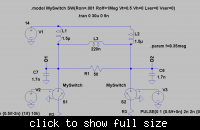mtwieg
Advanced Member level 6

Hello, I'm trying to build a current mode class D amp at ~8MHz, ~50W out. For this I'm trying to use the MRF1518 FET, but when I try to bring the power beyond a certain point, they always fail in the same way. I'll describe in detail what I'm doing.
Here's a rough schematic in LTspice of a low power tuning of the amp. The FETs are modeled as ideal switches (can't find an actual model to import, and it works well enough I believe) driven 180 degrees out of phase. In reality they are each driven by class E amps, with about 20Vpp on the gates. The L and Cs are chosen to give zero voltage switching. The load here is 50ohms. In the case the amp works fine, and I've taken the supply voltage up to 14VDC (about 18W out). Nothing heats up noticeably.

Here are the simulated waveforms of the FET drain currents and drain voltages. The boxes on the right show the max, min, RMS, and average of the drain currents.

Now I try to step up the power by dropping my load impedance to 12.5ohms (done in reality with 1:4 impedance transformer). I retune the L and Cs a bit to maintain good zero crossings. But now whenever I try to take the supply voltage above around 10V, one of the MOSFETs will fail. Here's what the waveforms look like under those simulated conditions.

So the actual currents aren't incredibly higher. The failures happen even when doing short (like 30us), non repetitive bursts of operation. Prior to bumping the supply voltage past 10V, the devices are completely cool. The datasheet for the devices is pretty vague when it comes to giving max ratings. It merely states the max "continuous DC current" is 4ADC, and that total device dissipation is limited to 62.5W (definitely not violating that limit...). When the failure happens, the peak drain voltage (that I can observe) is less than the rated breakdown voltage, and it's much less than it was during the first test (in which the load was 50ohms and the supply was 14V). The peak gate voltage is also less than the max rating (+/-20V).
When one of the FETs fails, its gate-source resistance always appears low, normally between 10 and 200ohms. Often the FET will still apparently work, though not nearly as well. This is always the case, and I've gone through about 6 FETs like this.
Does anyone have any ideas on what might be causing this sudden failure? Is there some physical phenomenon that just limits the peak current that I can push through the device, even for very short periods of time. If I change devices, how can I get more bang for my buck?
Here's a rough schematic in LTspice of a low power tuning of the amp. The FETs are modeled as ideal switches (can't find an actual model to import, and it works well enough I believe) driven 180 degrees out of phase. In reality they are each driven by class E amps, with about 20Vpp on the gates. The L and Cs are chosen to give zero voltage switching. The load here is 50ohms. In the case the amp works fine, and I've taken the supply voltage up to 14VDC (about 18W out). Nothing heats up noticeably.

Here are the simulated waveforms of the FET drain currents and drain voltages. The boxes on the right show the max, min, RMS, and average of the drain currents.

Now I try to step up the power by dropping my load impedance to 12.5ohms (done in reality with 1:4 impedance transformer). I retune the L and Cs a bit to maintain good zero crossings. But now whenever I try to take the supply voltage above around 10V, one of the MOSFETs will fail. Here's what the waveforms look like under those simulated conditions.

So the actual currents aren't incredibly higher. The failures happen even when doing short (like 30us), non repetitive bursts of operation. Prior to bumping the supply voltage past 10V, the devices are completely cool. The datasheet for the devices is pretty vague when it comes to giving max ratings. It merely states the max "continuous DC current" is 4ADC, and that total device dissipation is limited to 62.5W (definitely not violating that limit...). When the failure happens, the peak drain voltage (that I can observe) is less than the rated breakdown voltage, and it's much less than it was during the first test (in which the load was 50ohms and the supply was 14V). The peak gate voltage is also less than the max rating (+/-20V).
When one of the FETs fails, its gate-source resistance always appears low, normally between 10 and 200ohms. Often the FET will still apparently work, though not nearly as well. This is always the case, and I've gone through about 6 FETs like this.
Does anyone have any ideas on what might be causing this sudden failure? Is there some physical phenomenon that just limits the peak current that I can push through the device, even for very short periods of time. If I change devices, how can I get more bang for my buck?


